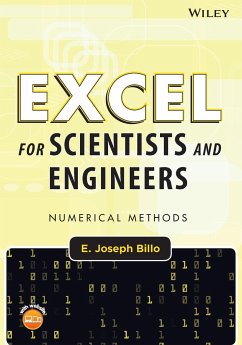With step-by-step instruction, this book illustrates how to use the scientific calculating power of Excel to perform a variety of chemical, biochemical, physical, engineering, biological, and medicinal calculations.
Learn to fully harness the power of Microsoft Excel(r) to perform scientific and engineering calculations
With this text as your guide, you can significantly enhance Microsoft Excel's(r) capabilities to execute the calculations needed to solve a variety of chemical, biochemical, physical, engineering, biological, and medicinal problems. The text begins with two chapters that introduce you to Excel's Visual Basic for Applications (VBA) programming language, which allows you to expand Excel's(r) capabilities, although you can still use the text without learning VBA. Following the author's step-by-step instructions, here are just a few of the calculations you learn to perform:
_
Use worksheet functions to work with matrices
_
Find roots of equations and solve systems of simultaneous equations
_
Solve ordinary differential equations and partial differential equations
_
Perform linear and non-linear regression
_
Use randomnumbers and the Monte Carlo method
This text is loaded with examples ranging from very basic to highly sophisticated solutions. More than 100 end-of-chapter problems help you test and put your knowledge to practice solving real-world problems. Answers and explanatory notes for most of the problems are provided in an appendix.
The CD-ROM that accompanies this text provides several useful features:
_
All the spreadsheets, charts, and VBA code needed to perform the examples from the text
_
Solutions to most of the end-of-chapter problems
_
An add-in workbook with more than twenty custom functions
This text does not require any background in programming, so it is suitable for both undergraduate and graduate courses. Moreover, practitioners in science and engineering will find that this guide saves hours of time by enabling them to perform most of their calculations with one familiar spreadsheet package.
Hinweis: Dieser Artikel kann nur an eine deutsche Lieferadresse ausgeliefert werden.
Learn to fully harness the power of Microsoft Excel(r) to perform scientific and engineering calculations
With this text as your guide, you can significantly enhance Microsoft Excel's(r) capabilities to execute the calculations needed to solve a variety of chemical, biochemical, physical, engineering, biological, and medicinal problems. The text begins with two chapters that introduce you to Excel's Visual Basic for Applications (VBA) programming language, which allows you to expand Excel's(r) capabilities, although you can still use the text without learning VBA. Following the author's step-by-step instructions, here are just a few of the calculations you learn to perform:
_
Use worksheet functions to work with matrices
_
Find roots of equations and solve systems of simultaneous equations
_
Solve ordinary differential equations and partial differential equations
_
Perform linear and non-linear regression
_
Use randomnumbers and the Monte Carlo method
This text is loaded with examples ranging from very basic to highly sophisticated solutions. More than 100 end-of-chapter problems help you test and put your knowledge to practice solving real-world problems. Answers and explanatory notes for most of the problems are provided in an appendix.
The CD-ROM that accompanies this text provides several useful features:
_
All the spreadsheets, charts, and VBA code needed to perform the examples from the text
_
Solutions to most of the end-of-chapter problems
_
An add-in workbook with more than twenty custom functions
This text does not require any background in programming, so it is suitable for both undergraduate and graduate courses. Moreover, practitioners in science and engineering will find that this guide saves hours of time by enabling them to perform most of their calculations with one familiar spreadsheet package.
Hinweis: Dieser Artikel kann nur an eine deutsche Lieferadresse ausgeliefert werden.

Drei Bücher für die Standard-Tabellenkalkulation von Microsoft
Sie feiert in diesem Jahr, je nach Zählung, 20. oder 25. Geburtstag: die Tabellenkalkulations-Software Excel von Microsoft. 1982 unter dem Namen Multiplan gestartet, erblickte sie unter heutigem Namen 1987 das Licht der Windows-Welt; zwei Jahre nachdem sie schon auf dem Mac lief. Seit 1993 verbreitet sich Excel als Bestandteil der Office-Suite und ist heute die am meisten genutzte Software ihrer Art. Die aktuelle zwölfte Version nimmt ihr dank freundlicherer Bedienung einiges vom bisher sperrig-zickigen Image. Dass die Tabellenkalkulation mehr als nur die Grundrechenarten beherrscht, blieb beinahe Geheimwissen. Deshalb lohnt gerade die neueste Fassung einen gezielten Blick auf die Formeln und der Programmierung in Visual Basic, VBA.
Bei Excel verbinden Rechenoperationen die Inhalte sogenannter Zellen. Jede Zelle im Rechenblatt hat eine eindeutige Position, markiert durch Buchstabe und Zahl. Wer addieren möchte, schreibt in das Ergebnisfeld in etwa: nimm die Zahl aus A1, addiere sie zur Zahl aus A2 und schreibe die Summe in das Feld A3. Da Mathematiker faul sind, verkürzt sich die Anweisung in Feld A3 zu =A1+A2.
Wir haben uns von drei kundigen Autoren an die Hand nehmen lassen. Bernd Held legt auf 700 Seiten höchst anschaulich die Grundlagen des Umgangs mit Funktionen und ihrer Anwendung. Hier geht es um die Fallstricke der von ihrer Fragestellung oft so einfachen alltäglichen Praxis - wie zeigt Excel Minusstunden an? -, die souverän gelöst werden. Wer einer kleinen Familie oder einer Ich-AG vorsteht, den versöhnen die 300 fertigen Lösungen von Arbeitszeiterfassung über Kalkulation, Haushaltsbuch und Zinsbelastung für Kredite einigermaßen mit der notwendigen Lernphase.
René Martin geht insbesondere in den Bereichen Mathematik und Statistik noch darüber hinaus. Zudem widmet er dem Thema "Diagramme erstellen" ein Kapitel. Der Autor schätzt und kritisiert Excel schon so lange, dass er die vielen Stärken ebenso kennt wie die von Version zu Version mitgeschleppten Inkonsistenzen. Neben einer sehr klaren Darstellung trägt der produktiv-kritische Impetus erheblich zum erfreulichen Nutzwert bei.
Nur in Englisch hingegen liegt der gelungene Versuch des emeritierten Chemieprofessors E. Joseph Billo vor, der die wissenschaftlichen Kapazitäten von Excel ausschöpft und daher gleich mit zwei Kapiteln über die VBA-Programmierung startet. Danach werden gewöhnliche und partielle Differentialgleichungen gelöst, einzelne Messpunkte nach verschiedenen Methoden zu Kurven geglättet, und es wird nach den Regeln der Kunst mit Zufällen gespielt. Was Billo treibt, rückt Excel beinahe gleichberechtigt an die Seite spezieller Mathematik-Software - nur dass dieses Kalkulationsprogramm als Teil von Office 2007 auf besseren Rechnern schon auf seinen Einsatz lauert.
NILS SCHIFFHAUER
Excel 2007 - Formeln und Funktionen. Von Bernd Held. 700 Seiten, bhv, Heidelberg, 19,95 Euro; Berechnungen in Excel. Von René Martin. 462 Seiten, Hanser, München, 24,90 Euro; Excel for Scientists and Engineers. Von E. Joseph Billo, 454 Seiten plus CD mit allen Tabellen und VBA-Programmen, Wiley & Sons, Hoboken, 44,90 Euro.
Alle Rechte vorbehalten. © F.A.Z. GmbH, Frankfurt am Main








